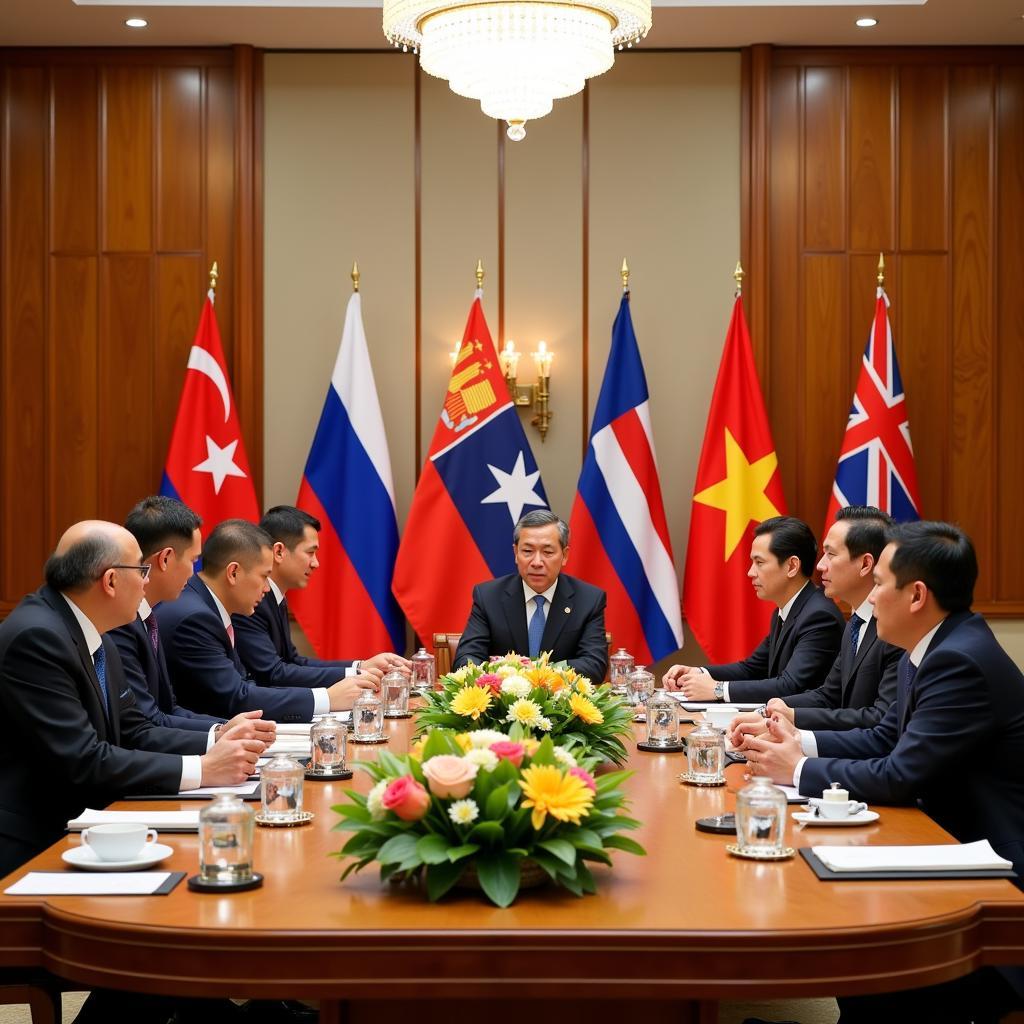The ASEAN abbreviation, a cornerstone of Southeast Asian geopolitics and economics, represents a dynamic and influential bloc of nations. This article delves into the meaning, history, and significance of the ASEAN acronym, exploring its impact on regional cooperation and global affairs. We’ll uncover the key roles of ASEAN member states, examine the organization’s structure, and discuss its future prospects.
What Does the ASEAN Abbreviation Stand For?
The ASEAN abbreviation stands for the Association of Southeast Asian Nations. This seemingly simple acronym represents a complex and evolving entity that has played a crucial role in shaping the political, economic, and social landscape of Southeast Asia for over five decades. Formed in 1967, ASEAN initially comprised five founding members: Indonesia, Malaysia, the Philippines, Singapore, and Thailand. abbreviation for asean Over the years, the organization has expanded to include Brunei, Cambodia, Laos, Myanmar, and Vietnam, solidifying its position as a major regional player.
The History and Evolution of ASEAN
Understanding the ASEAN abbreviation requires a look back at its historical context. Born out of the Cold War era, ASEAN initially focused on promoting regional stability and cooperation amidst political tensions. The Bangkok Declaration of 1967 laid the foundation for the organization’s principles of peace, neutrality, and economic development. As the Cold War ended, ASEAN shifted its focus towards economic integration and trade liberalization. The ASEAN Free Trade Area (AFTA) and the ASEAN Economic Community (AEC) are testaments to this commitment.
Key Objectives of ASEAN: More Than Just an Abbreviation
The abbreviation of asean represents more than just a name. It embodies a set of core objectives that drive the organization’s activities. These include:
- Promoting regional peace and stability through dialogue and diplomacy
- Accelerating economic growth, social progress, and cultural development
- Enhancing regional resilience through cooperation in various sectors
- Promoting active collaboration and mutual assistance on matters of common interest
ASEAN’s Structure and Functioning
How does ASEAN operate? The organization has a well-defined structure that facilitates decision-making and implementation of its objectives. The ASEAN Summit, comprising the heads of state of member countries, is the supreme decision-making body. The ASEAN Secretariat, based in Jakarta, provides administrative support and coordination. Various sectoral bodies and committees work on specific areas of cooperation, such as trade, security, and culture.
 ASEAN Summit Meeting
ASEAN Summit Meeting
What is the role of the ASEAN Secretariat?
The ASEAN Secretariat plays a vital role in supporting the organization’s functions. It provides administrative and logistical support for meetings, coordinates the implementation of ASEAN programs, and facilitates communication among member states. The Secretariat acts as a central hub for information dissemination and plays a key role in promoting ASEAN’s image on the global stage.
The Future of ASEAN
Looking ahead, ASEAN faces both opportunities and challenges. The rise of Asia presents opportunities for greater economic integration and regional influence. However, managing internal diversity and navigating geopolitical complexities remain key challenges. Strengthening regional connectivity, promoting sustainable development, and fostering people-to-people exchanges are crucial for ASEAN’s continued success.
abbreviation of asean countries holds significant promise. The organization is poised to play an even greater role in shaping the future of Southeast Asia and contributing to global peace and prosperity.
Conclusion: ASEAN – Beyond the Abbreviation
The ASEAN abbreviation signifies a dynamic and impactful organization. It represents a collective effort to build a more peaceful, prosperous, and integrated Southeast Asia. As ASEAN continues to evolve, its role in regional and global affairs will only become more prominent.
FAQs
- What are the main pillars of the ASEAN Community? The three pillars are the ASEAN Political-Security Community, the ASEAN Economic Community, and the ASEAN Socio-Cultural Community.
- How does ASEAN promote economic cooperation? ASEAN promotes economic cooperation through initiatives like the ASEAN Free Trade Area (AFTA) and the ASEAN Economic Community (AEC).
- What is the role of ASEAN in conflict resolution? ASEAN plays a vital role in regional conflict resolution through dialogue, diplomacy, and confidence-building measures.
- How can I get involved with ASEAN? Various opportunities exist for engagement with ASEAN, including academic programs, internships, and civil society organizations.
- Where can I find more information about ASEAN? The official ASEAN website and various research institutions provide comprehensive information.
 ASEAN Flag
ASEAN Flag
Common Scenarios & Questions:
Scenario: A student researching the economic impact of ASEAN.
Question: How has the ASEAN Free Trade Area impacted intra-regional trade?
Scenario: A businessperson exploring investment opportunities in Southeast Asia.
Question: What are the key regulations and incentives for foreign investors in ASEAN countries?
Scenario: A traveler planning a trip to Southeast Asia.
Question: What are the visa requirements for traveling within the ASEAN region?
Further Exploration:
For more in-depth information on specific ASEAN-related topics, you can also explore these articles:
Contact Us
For assistance or further inquiries, please contact us:
Phone: 0369020373
Email: [email protected]
Address: Thon Ngoc Lien, Hiep Hoa, Bac Giang, Vietnam.
We have a 24/7 customer support team ready to assist you.

